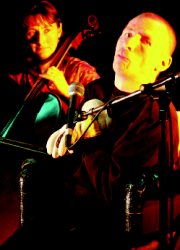Technology has helped the Drake Music Project in its efforts to increase music-making opportunities for disabled musicians.
The Drake Music Project was established in 1988 to enable disabled children and adults who are unable to play conventional musical instruments to discover their musical abilities and explore, compose and perform their own music. We have a track record in delivering a wide range of initiatives (outreach, R & D, training) across England, and our staff currently work in London and the South East, Manchester, Bristol and Milton Keynes. Through the combination of music technology and assistive technology, we utilise specialist and adapted computer/music software and hardware to facilitate the composition and preparation of music for concert performance, theatre or dance.
Since the 1980s, new technologies have made the computer a more accessible tool for people with physical disabilities. Joysticks, switches, keyboard emulation programs, software overlays, head pointers and eye scan software can all be used separately or in conjunction with each other to make the computer environment more accessible. The increased availability and affordability of new technology has meant that previously inaccessible mainstream music software has been made more accessible to disabled musicians, allowing them to compose and perform on professional-level software. So much of the music we listen to today has been composed on a computer. Pop music, film scores, television themes and music for adverts are now very often written purely within the computer environment. This means that a disabled musician can write music for these mediums using exactly the same tools as a non-disabled musician.
Making the arts accessible is about equality of opportunity both for the artist and the audience. Appropriate equipment can give disabled musicians access to performing live on stage, effectively giving them their own specialist instruments. For example, specialist devices can track and capture a performers movements, whether of a finger, eye, foot, arm or the whole body (e.g. dancing, rolling or even driving an electric wheelchair). Once captured, the performers movements can then generate or control live music in a huge variety of ways, using specialist music-technology hardware, or even computer software with appropriate set-up and techniques thus a computer can be used as a live instrument.

Audiences can often have problems in accessing the essence of the performance by a disabled musician on stage, in the way they might enjoy watching someone playing, say, the violin. They can have difficulties in seeing and understanding what a performer is doing, and understanding the connection with the music they are hearing (often from loudspeakers). This is especially so when musicians are using specialist equipment whose operation is unknown to the audience, and which may be making very small and/or unconventional movements. Various techniques have been used by Drake Music to help an audience during the performance, including hand-held video cameras with large-screen projection, lighting to focus on specific performers, and a pre-prepared visual backdrop (with or without music backing) that features the performers, perhaps rehearsing, or in other ways making their techniques obvious. In future, Drake Music plans to investigate visual elements that respond more directly to performers movements. For example, a tiny finger movement can be converted into percussion sounds, but in addition can control a computer-animated drum-stick that can be projected on a large screen behind the performer. The movement, size, or brightness of the stick can reflect changes to the sound, and thus visually reinforce the performers movements.
There is no easy answer to this issue live visual elements and/or additional personnel on stage can change the nature and balance of the performance, and can in many cases dissipate the focus on the disabled performers, or distract the audience from the music. However, having a performance planned around dance or movement of performers tied into musical output is often successful, helping the audience to connect what they are seeing with the music they are hearing.
Access is, however, about more than just the tools. Creativity can only flourish in an open environment. In making arts accessible we encounter specific challenges depending on the artform. It has often been said that computers have made the process of making music too easy,, but this is simply not the case. You still need talent to write good music using modern technology: all it has done is bridged the gap between a non-disabled musician and a disabled musician. Being accessible doesnt mean compromising quality. Drake Music aims to enable all musicians to create great music of a high standard and to the best of everyones abilities.
Dr Tim Anderson, Paul Crawford and Mick Lawton contributed to this article. To contact Drake Music Project:
t: 020 8692 9000;
e: info@drakemusicproject.org;
w: http://www.drakemusicproject.org.



